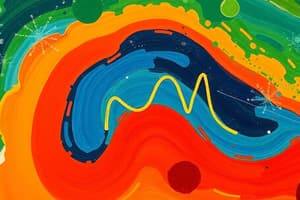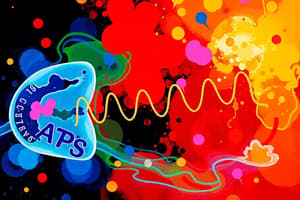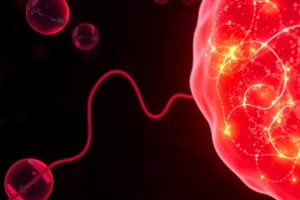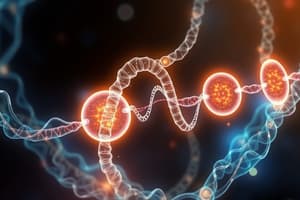Podcast
Questions and Answers
What is the primary role of enzyme organization within glycolysis?
What is the primary role of enzyme organization within glycolysis?
- To facilitate efficient transfer of substrates between enzymes. (correct)
- To modify the pH levels within the cytoplasm.
- To decrease the amount of ATP produced during the process.
- To increase the overall temperature of the reaction.
During the energy investment phase of glycolysis, what is the fate of glucose?
During the energy investment phase of glycolysis, what is the fate of glucose?
- It is phosphorylated and split into two three-carbon molecules. (correct)
- It is oxidized, producing NADH.
- It is dephosphorylated to produce free glucose.
- It is directly converted into pyruvate.
Which enzyme is responsible for catalyzing the conversion of glucose to glucose-6-phosphate in the initial step of glycolysis?
Which enzyme is responsible for catalyzing the conversion of glucose to glucose-6-phosphate in the initial step of glycolysis?
- Phosphofructokinase-1
- Triose phosphate isomerase
- Hexokinase (correct)
- Phosphoglucose isomerase
What enzymatic reaction is bypassed in gluconeogenesis, that is catalyzed by PFK-1 in glycolysis?
What enzymatic reaction is bypassed in gluconeogenesis, that is catalyzed by PFK-1 in glycolysis?
What key conversion is catalyzed by triose phosphate isomerase?
What key conversion is catalyzed by triose phosphate isomerase?
During the energy payoff phase of glycolysis, how many times does each reaction occur per glucose molecule?
During the energy payoff phase of glycolysis, how many times does each reaction occur per glucose molecule?
What is the role of glyceraldehyde 3-phosphate dehydrogenase in glycolysis?
What is the role of glyceraldehyde 3-phosphate dehydrogenase in glycolysis?
Which enzyme generates ATP through substrate-level phosphorylation by converting 1,3-bisphosphoglycerate to 3-phosphoglycerate?
Which enzyme generates ATP through substrate-level phosphorylation by converting 1,3-bisphosphoglycerate to 3-phosphoglycerate?
What is the function of phosphoglycerate mutase in glycolysis?
What is the function of phosphoglycerate mutase in glycolysis?
Which enzyme is responsible for converting 2-phosphoglycerate to phosphoenolpyruvate (PEP) during glycolysis?
Which enzyme is responsible for converting 2-phosphoglycerate to phosphoenolpyruvate (PEP) during glycolysis?
How is energy generated during the conversion of glyceraldehyde 3-phosphate to 1,3-bisphosphoglycerate?
How is energy generated during the conversion of glyceraldehyde 3-phosphate to 1,3-bisphosphoglycerate?
Which of the following reactions is an example of substrate-level phosphorylation in glycolysis?
Which of the following reactions is an example of substrate-level phosphorylation in glycolysis?
What is the net reaction of glycolysis?
What is the net reaction of glycolysis?
Why is the regeneration of $NAD^+$ essential for glycolysis to continue?
Why is the regeneration of $NAD^+$ essential for glycolysis to continue?
Under anaerobic conditions, what is the primary purpose of lactic acid fermentation?
Under anaerobic conditions, what is the primary purpose of lactic acid fermentation?
In what type of cells does lactic acid fermentation typically occur?
In what type of cells does lactic acid fermentation typically occur?
How does fructose enter glycolysis in the liver?
How does fructose enter glycolysis in the liver?
What is the initial step in the conversion of galactose to glucose-6-phosphate?
What is the initial step in the conversion of galactose to glucose-6-phosphate?
Which of the following enzymes is inhibited by glucose-6-phosphate, serving as a regulator of glycolysis?
Which of the following enzymes is inhibited by glucose-6-phosphate, serving as a regulator of glycolysis?
What role does fructose-2,6-bisphosphate play in the regulation of glycolysis and gluconeogenesis?
What role does fructose-2,6-bisphosphate play in the regulation of glycolysis and gluconeogenesis?
Flashcards
Glycolysis
Glycolysis
The metabolic pathway that converts glucose into pyruvate, generating ATP and NADH.
Energy Investment Phase
Energy Investment Phase
The first phase of glycolysis where glucose is phosphorylated and split, requiring ATP.
Energy Payoff Phase
Energy Payoff Phase
The second phase of glycolysis where ATP and NADH are produced through substrate-level phosphorylation.
Hexokinase
Hexokinase
Signup and view all the flashcards
Phosphoglucose Isomerase
Phosphoglucose Isomerase
Signup and view all the flashcards
Phosphofructokinase-1 (PFK-1)
Phosphofructokinase-1 (PFK-1)
Signup and view all the flashcards
Aldolase
Aldolase
Signup and view all the flashcards
Triose phosphate isomerase
Triose phosphate isomerase
Signup and view all the flashcards
Glyceraldehyde 3-phosphate dehydrogenase
Glyceraldehyde 3-phosphate dehydrogenase
Signup and view all the flashcards
Phosphoglycerate kinase
Phosphoglycerate kinase
Signup and view all the flashcards
Phosphoglycerate mutase
Phosphoglycerate mutase
Signup and view all the flashcards
Enolase
Enolase
Signup and view all the flashcards
Pyruvate kinase
Pyruvate kinase
Signup and view all the flashcards
Cori Cycle
Cori Cycle
Signup and view all the flashcards
Pyruvate Translocase
Pyruvate Translocase
Signup and view all the flashcards
Phosphofructokinase-1 (PFK-1) Regulation
Phosphofructokinase-1 (PFK-1) Regulation
Signup and view all the flashcards
Pyruvate Kinase Regulation
Pyruvate Kinase Regulation
Signup and view all the flashcards
Hexokinase Regulation
Hexokinase Regulation
Signup and view all the flashcards
Conversion of Glucose-6-Phosphate
Conversion of Glucose-6-Phosphate
Signup and view all the flashcards
Insulin Role
Insulin Role
Signup and view all the flashcards
Study Notes
Overview of Glycolysis
- This metabolic pathway converts glucose to pyruvate, generating ATP and NADH
- It takes place in the cell's cytoplasm
- Glycolysis enzymes are organized sequentially for efficient substrate transfer
Two Stages of Glycolysis
- Stage 1 is the Energy Investment Phase
- Glucose is phosphorylated and split into two 3-carbon molecules
- This stage requires ATP input
- Stage 2 is the Energy Payoff Phase
- ATP and NADH are produced through substrate-level phosphorylation
- Each reaction happens twice per glucose molecule
Steps in Stage 1 of Glycolysis
- Hexokinase catalyzes the phosphorylation of glucose to glucose-6-phosphate, using ATP
- Phosphoglucose isomerase converts glucose-6-phosphate into fructose-6-phosphate
- Phosphofructokinase-1 (PFK-1) phosphorylates fructose-6-phosphate to fructose-1,6-bisphosphate, using ATP
- Aldolase splits fructose-1,6-bisphosphate into glyceraldehyde-3-phosphate (G3P) and dihydroxyacetone phosphate (DHAP)
- Triose phosphate isomerase converts DHAP into G3P
- One 6-carbon glucose is converted into two 3-carbon molecules (G3P)
Steps in Stage 2 of Glycolysis
- Glyceraldehyde 3-phosphate dehydrogenase oxidizes G3P to 1,3-bisphosphoglycerate, generating NADH
- Phosphoglycerate kinase converts 1,3-bisphosphoglycerate to 3-phosphoglycerate, producing ATP via substrate-level phosphorylation
- Phosphoglycerate mutase converts 3-phosphoglycerate into 2-phosphoglycerate
- Enolase converts 2-phosphoglycerate to phosphoenolpyruvate (PEP)
- Pyruvate kinase converts PEP to pyruvate, producing ATP via substrate-level phosphorylation
- Each step occurs twice per glucose molecule, leading to net ATP and NADH production
Glyceraldehyde 3-Phosphate to 1,3-Bisphosphoglycerate
- Oxidation of G3P generates energy
- The energy attaches an inorganic phosphate, forming a high-energy acyl-phosphate intermediate
- This coupling thermodynamically favors the reaction
Enzymes and Their Functions
- Hexokinase phosphorylates glucose using ATP
- Phosphofructokinase-1 (PFK-1) is a major regulatory enzyme, adding a second phosphate to fructose-6-phosphate
- Aldolase splits fructose-1,6-bisphosphate into two 3-carbon sugars
- Glyceraldehyde 3-phosphate dehydrogenase produces NADH and forms acyl-phosphate
- Phosphoglycerate kinase generates ATP via substrate-level phosphorylation
- Pyruvate kinase converts PEP to pyruvate, producing ATP
Types of Reactions by Enzymes
- Kinases transfer phosphate groups (e.g., hexokinase, PFK-1, pyruvate kinase)
- Phosphatases remove phosphate groups
- Dehydrogenases catalyze oxidation-reduction reactions (e.g., glyceraldehyde 3-phosphate dehydrogenase)
Recognizing Phosphorylated Molecules
- The number of phosphates present can be recognized from the name (e.g., fructose-1,6-bisphosphate has 2 phosphates)
Substrate-Level Phosphorylation
- A direct transfer of a phosphate group to ADP forms ATP
- This occurs in the phosphoglycerate kinase reaction (1,3-BPG to 3-PG) and the pyruvate kinase reaction (PEP to pyruvate)
Net Reaction of Glycolysis
- Glucose + 2 NAD⁺ + 2 ADP + 2 Pi → 2 Pyruvate + 2 NADH + 2 ATP + 2 H₂O + 2 H⁺
NAD⁺ Regeneration
- Essential for glycolysis to continue
- There are 3 pathways for pyruvate metabolism:
- Aerobic: Pyruvate enters the TCA cycle, and NADH donates electrons to the electron transport chain
- Lactic Acid Fermentation: Pyruvate becomes Lactate (via lactate dehydrogenase, regenerates NAD⁺)
- Ethanol Fermentation: Pyruvate becomes Acetaldehyde, which becomes Ethanol (regenerates NAD⁺, occurs in yeast)
Ethanol Fermentation
- Steps: Pyruvate → Acetaldehyde (via pyruvate decarboxylase, releases CO₂), then Acetaldehyde → Ethanol (via alcohol dehydrogenase, regenerates NAD⁺)
- Net Reaction: Glucose → 2 Ethanol + 2 CO₂ + 2 ATP
- Occurs in yeast and some bacteria
Lactic Acid Fermentation
- Steps: Pyruvate → Lactate (via lactate dehydrogenase, regenerates NAD⁺)
- Net Reaction: Glucose → 2 Lactate + 2 ATP
- Occurs in muscle cells during anaerobic respiration
Fructose Entry into Glycolysis
- Two pathways exist:
- In the liver: Fructose → Fructose-1-phosphate → DHAP + G3P (via fructokinase and aldolase B)
- In muscle: Fructose is directly phosphorylated to fructose-6-phosphate (via hexokinase)
Galactose Conversion to Glucose 6-Phosphate
- Steps: Galactose → Galactose-1-phosphate (via galactokinase), then Galactose-1-phosphate → UDP-galactose, then UDP-galactose → UDP-glucose, and finally UDP-glucose → Glucose-6-phosphate
Two Roles of Glycolysis
- This is the mechanism for energy production (ATP generation)
- Provides intermediates for biosynthetic pathways
Regulation of Glycolysis
- Three key enzymes regulate glycolysis:
- Hexokinase is inhibited by glucose-6-phosphate
- Phosphofructokinase-1 (PFK-1) is activated by AMP & fructose-2,6-bisphosphate and inhibited by ATP & citrate
- Pyruvate kinase is activated by fructose-1,6-bisphosphate and inhibited by ATP & alanine
- Muscle regulation is based on energy demand
- Liver regulation maintains blood glucose levels
Glucose Transporters (GLUTs)
- GLUT1 is found in most cells for basal glucose uptake
- GLUT2 is in the liver and pancreas for bidirectional transport
- GLUT3 is in neurons as a high-affinity transporter
- GLUT4 is in muscle and fat for insulin-dependent uptake
- GLUT5 is a fructose transporter in the small intestine
Overview of Gluconeogenesis
- A metabolic pathway generating glucose from non-carbohydrate precursors
- Maintains blood glucose during fasting or prolonged exercise
- Occurs mainly in the liver, kidneys to a lesser extent
Precursors for Gluconeogenesis
- Lactate comes from anaerobic glycolysis in muscle, entering via the Cori cycle
- Amino acids (except leucine & lysine) are converted into intermediates of the TCA cycle
- Glycerol comes from triglyceride breakdown, entering as dihydroxyacetone phosphate (DHAP)
Irreversible Steps of Glycolysis That Are Bypassed
- Steps are bypassed involving:
- Glucokinase/Hexokinase to Glucose-6-phosphatase
- Phosphofructokinase-1 (PFK-1) to Fructose-1,6-bisphosphatase
- Pyruvate kinase to Pyruvate carboxylase & PEP carboxykinase
First Step of Gluconeogenesis
- Pyruvate turns to Oxaloacetate (OAA)
- Pyruvate carboxylase catalyzes this, needing ATP and biotin
- This occurs in the mitochondria
Oxaloacetate Conversion and Transport
- OAA reduces to malate to cross the mitochondrial membrane, oxidizing back to OAA in the cytoplasm
- OAA becomes phosphoenolpyruvate (PEP) with PEP carboxykinase (PEPCK)
- The PEP conversion consumes GTP
Net Reaction of Pyruvate to PEP
- 2 Pyruvate + 2 ATP + 2 GTP → 2 PEP + 2 ADP + 2 GDP + 2 CO₂
Conversion of Fructose-1,6-bisphosphate to Fructose-6-phosphate
- Catalyzed by fructose-1,6-bisphosphatase
Conversion of Glucose-6-Phosphate to Free Glucose
- Glucose-6-phosphatase is the enzyme
- This occurs in the endoplasmic reticulum of liver and kidney cells
- Glucose-6-phosphate is transported into the ER for dephosphorylation, then free glucose is exported
Net Reaction of Gluconeogenesis
- 2 Pyruvate + 4 ATP + 2 GTP + 2 NADH → Glucose + 4 ADP + 2 GDP + 6 Pi + 2 NAD⁺
- Gluconeogenesis needs 6 ATP equivalents, making it more energy-intensive than glycolysis
Regulation of Glycolysis vs. Gluconeogenesis
- Mutual regulation is present, which prevents the pathways from operating simultaneously
- Key regulators include:
- High ATP & citrate stimulate gluconeogenesis and inhibit glycolysis
- High AMP stimulates glycolysis and inhibits gluconeogenesis
Key Enzymes & Blood Glucose Regulation
- Fructose-2,6-bisphosphate is a critical regulator
- High levels activate PFK-1 (glycolysis) and inhibit fructose-1,6-bisphosphatase (gluconeogenesis)
- Low levels do the opposite
- A bifunctional enzyme, PFK-2/FBPase-2, controls fructose-2,6-bisphosphate levels
- Regulated by insulin (stimulates glycolysis) and glucagon (stimulates gluconeogenesis)
Cori Cycle
- Transports lactate from muscles to the liver for glucose conversion
- Steps:
- Anaerobic glycolysis in muscles generates lactate
- Lactate enters the bloodstream and reaches the liver
- The liver converts lactate back to glucose via gluconeogenesis
- Glucose is released back into the bloodstream and taken up by muscles
Conditions for Pyruvate to Enter Aerobic Respiration
- Oxygen must be present, allowing Pyruvate to proceed to the citric acid cycle
- Pyruvate is transported into the mitochondrial matrix via the pyruvate translocase protein
Pyruvate Transport & Conversion to Acetyl-CoA
- Pyruvate translocase moves pyruvate into the mitochondrial matrix by transport
- Reaction Steps:
- Decarboxylation occurs as pyruvate loses a CO₂ molecule
- Oxidation occurs as the remaining 2-carbon molecule is oxidized, reducing NAD⁺ to NADH
- Coenzyme A is added as the 2-carbon fragment attaches to Coenzyme A, forming Acetyl-CoA
- This process is due to the enzyme pyruvate dehydrogenase complex (PDC)
- The reaction produces Acetyl-CoA, CO₂, and NADH
Fates of Acetyl-CoA
- Acetyl-CoA enters the TCA cycle for ATP production
- Lipid synthesis occurs in high-energy conditions, using Acetyl-CoA for fatty acid synthesis
Pyruvate Dehydrogenase Complex (PDC) Components
- The enzymes involved include:
- E1: Pyruvate dehydrogenase
- E2: Dihydrolipoyl transacetylase
- E3: Dihydrolipoyl dehydrogenase
- The catalytic coenzymes (not consumed) include thiamine pyrophosphate (TPP), lipoamide, and FAD
- Stoichiometric coenzymes (used up) include Coenzyme A and NAD⁺
Steps in Pyruvate to Acetyl-CoA Conversion
- Decarboxylation is when pyruvate is bound by E1, releasing CO₂
- Oxidation occurs as lipoamide on E2 transfers the remaining 2-carbon unit
- Acetyl-CoA formation occurs as the acetyl group is transferred to Coenzyme A by E2
- Regeneration of lipoamide occurs as E3 transfers electrons to FAD, then to NAD⁺
Rate-Limiting Step of Pyruvate Decarboxylation
- Pyruvate dehydrogenase (E1) carries this out
- This step commits pyruvate to aerobic metabolism
Oxidation Step in Pyruvate Conversion
- Starts with the Hydroxyethyl-TPP intermediate
- Ends with the Acetyl group bound to lipoamide
- Dihydrolipoyl transacetylase (E2) is what carries this out
Formation of Acetyl-CoA
- Acetyl-lipoamide is the substrate
- Acetyl-CoA is the product
- Dihydrolipoyl transacetylase (E2) is the enzyme
Regeneration of Lipoamide
- Enzyme: Dihydrolipoyl dehydrogenase (E3)
- FAD oxidizes lipoamide, then transfers electrons to NAD⁺
- Product: NADH
Pyruvate Dehydrogenase Regulation
- Allosteric regulation involves:
- Inhibitors: ATP, NADH, Acetyl-CoA (high energy state)
- Activators: ADP, Pyruvate (low energy state)
- Covalent regulation involves:
- Pyruvate dehydrogenase kinase (PDK) phosphorylates and inactivates PDC
- Pyruvate dehydrogenase phosphatase (PDP) dephosphorylates and activates PDC
Regulation by Metabolic Signals
- PDK Activation (inhibits PDC) by NADH, Acetyl-CoA, ATP
- PDK Inhibition (activates PDC) by ADP, Pyruvate
- PDP Activation (activates PDC) by Ca²⁺, and promotes energy production in active tissues
Studying That Suits You
Use AI to generate personalized quizzes and flashcards to suit your learning preferences.




